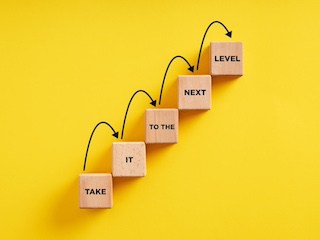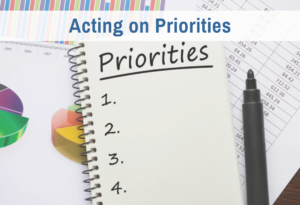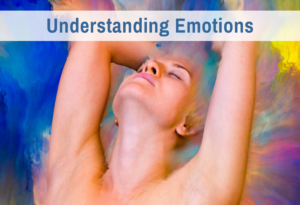In preparation for a new series of classes on “The Work of Happiness” in the Thinking Lab, I have been doing some high-level thinking about how you raise your baseline happiness.
As I wrote in How Do You Measure Happiness?, your “baseline happiness” is the overall percentage of your waking time in which you are in a good emotional state. By a “good emotional state,” I include both serenity and any state of happiness, as opposed to any state of suffering. So, peacefulness, even if you are sad, counts as a “good” state. But conflict or indecision, even if it concerns deciding between two good things, does not. (For a refresher on happiness, serenity, and suffering, see the first few articles in this continuing series on the concept of happiness.)
Baseline happiness tends to be fairly stable, because three personal characteristics relate directly to it: emotional resilience, self-esteem, and passion. In this article I’ll explain how they contribute to baseline happiness in different ways, and how, even though they are stable, they can be changed over time.
Emotional resilience
Emotional resilience is your ability to recover your mental balance after intense emotions, especially painful ones. When you’re extremely distressed, emotional resilience allows you to get back quickly to at least a state of serenity. That means you spend less time suffering, and have relatively higher baseline happiness.
For example, think of how you would react to hearing that you were losing your job. Would it send you into a funk for days or weeks? Or would you be able to come to terms with it and start thinking constructively about your future within a couple of days?
Or if everything went wrong in your morning routine, would this affect your whole day or would you be back to your normal self by the time you had started the first activity of the day?
I used to think that emotional resilience was an unchanging personality trait like temperament in children. But I don’t believe that anymore. Rather, I see it as a result of having certain specific knowledge and skills. If you have the skills, you characteristically recover faster. If you don’t, you don’t.
What convinced me was that I significantly improved my own emotional resilience. It’s a learnable skill, but what you need to learn may not be obvious. It wasn’t to me.
Theory
First, you need the right theoretical understanding of emotional states. You need to become convinced that your suffering is increased and magnified by the way you think about the situation.
For example, spending your time trying to understand everything bad about a situation, including true conclusions such as “this was unjust,” perpetuates your suffering. This is partly because of the additional negative emotions that that work generates, but it’s mostly because your continuing focus on the problem literally delays you from figuring out how to pursue your top values going forward.
In his book Quiet Leadership, David Rock makes a great observation: When faced with a problem, people often turn their attention to understanding why they have the problem, because they find that very interesting. But figuring out what to do about it is usually a much better use of their time. For example, suppose you have difficulty working with someone at your company. Analyzing why there’s a problem may be interesting, but figuring out how to get work done (despite the person) may be more useful.
This is counterintuitive to many people.
Practice
In addition, you need practical methods to implement the theory.
For example, you need to learn how to break out of a vicious cycle of negative emotions. Such vicious cycles occur by default, but if you learn to monitor for them, you can intervene. If you don’t intervene, focusing on the problems triggers other negatives, which creates a self-reinforcing negative loop.
But it’s not enough to notice that you’re in a vicious cycle. To break out, you need a practical intervention that helps you become value-oriented. (Hint: self-criticism is not the way.) You need to find ways to take constructive action.
These are learnable skills, but they require deliberate practice to master.
Self-Esteem
Self-esteem is “your conviction that you are able to live and worthy of living” (Ayn Rand). When you keep this fact in mind, you ensure that any suffering “only goes down so far”; drawing on self-esteem limits the depth of suffering.
If you haven’t experienced this effect firsthand, this idea may be a little floaty to you. I first heard about it reading a well-known passage from The Fountainhead in which Howard Roark says, “I’m not capable of suffering completely. I never have. It goes only down to a certain point and then it stops. As long as there is that untouched point, it’s not really pain.” This was explained to me as a result of his having self-esteem.
I didn’t really know what it meant, but it sure sounded good! Now I understand it in a novel way. I think most good and mixed people have a basic sense of self-esteem, but they don’t hold that context in some situations, and they don’t know how to activate that context.
I now have a process I call “Having Your Own Back” that takes about 3 minutes. I use it to activate a self-esteem context — in effect to remind myself that I am all-in on embracing reality, that I take my values seriously, and that one way or another, I am able to deal with whatever comes up in my life. This dramatic shift in perspective gives me a backstop on suffering. It didn’t used to be true for me, but now it is true for me that “the suffering only goes down so far.”
I use this process whenever I notice a whiff of self-doubt, which is on average a couple of times a day. This fast process grew out of longer processes that I used for getting out of funks. I still have those longer processes available to me, but I need them only very occasionally, and the funks are less painful.
For example, just a couple of weeks ago, I was in a growly mood I couldn’t shake, which was frustrating and painful. But the frustration was accented with curiosity about what was going on. I knew there was some important value at stake. I suspected it had been repressed, because it took several different tactics to get a handle on it. When I finally figured out the source of the funk, I felt an immense sense of pride and a huge optimism about my future — because I could see myself letting go of the old baggage. Needless to say, having and using these processes have led to a dramatic increase in my baseline happiness.
And I learned how to do it by a deliberate process. You can learn it too, but like the process of developing emotional resilience, it’s not obvious.
Theory
For one thing, you need a “values ethics,” as I discuss in my article on The Role of Philosophy in Happiness.
For another, you need to be intellectually convinced that you are able to live and worthy of living — that you do have self-esteem in some sense.
This can be more or less difficult.
Often, darn good people believe they lack self-esteem because they get into miserable situations that it seems like self-esteem should have kept them out of. But with a little coaching, they can see that they do believe they are worthy and they do believe they are able to deal with whatever situation they face. This often gets them moving forward again in a particular situation, but it also serves to make their self-esteem explicit.
Sometimes depressed people consciously believe they are unworthy and/or incapable. I don’t want to minimize the difficulties of depression or claim that I have some special insight into it. I will just say that cognitive-behavioral therapy has a good track record of helping people out of depression by getting them to act to gain and keep their values — starting with everyday values like showering and taking a walk outdoors.
Acting to gain values is the key to reclaiming a sense of self-efficacy. You need to start by tackling small goals that you can achieve and dealing with the small problems that you can solve. In this way, you learn basic skills for dealing with little setbacks and small failures so they don’t stop you. This starts a virtuous cycle that gives you the knowledge, values, and skill to pursue ever larger goals and deal with ever more complex problems. Once you get a virtuous cycle going, you can see that in principle, the sky’s the limit. It is seeing for yourself that convinces you that you are able to live, you are efficacious.
Separately, sometimes people need a special effort to conclude they are worthy. In such a case, they need to deal with issues from their past that they are ashamed of. This is done in various ways, but all of the methods I know involve facing past mistakes, taking full responsibility for them, and fully accepting their consequences.
To turn around dissatisfaction with your past, it helps to see how past mistakes led you to become the unique person you are now, with the unique set of values you have now. When you see that your current strengths and values are partly a result of your past mistakes, you can put the past to bed and reinforce your respect for yourself as you are now.
Practice
As I mentioned earlier, the intellectual conclusion is not enough. Frankly, the only tactics I know for activating a self-esteem context are the ones I’ve developed.
You also need practical tactics for dealing with guilt — earned and unearned — and you need my 3-minute tactic for defusing self-doubt.
These, too, are learnable skills.
And fortunately, the improvements in your happiness don’t need to wait for such skills to be automatized. Just working on this issue and practicing such tactics can significantly raise your baseline happiness.
Passion
Finally, your passion is the characteristic intensity of your emotions. It reflects the depth of meaning you find in the actions you take on a daily basis. Passion magnifies your highs and lows.
So, for example, if you see everything around you as the product of your choices, you will get extra pleasure out of every tidy room, every item you buy, every piece of music you hear, etc. On the other hand, you will get extra pain out of everything that goes wrong, every mistake you make, etc.
Some people find that pain so bad that they repress their values rather than find a lot of meaning in things around them.
Other people become resigned to the lows associated with passion. They say, “Life is 50:50,” so they accept a low baseline happiness, a life of happiness mixed with suffering.
But if you have emotional resilience and you know how to activate a self-esteem context, passion becomes an unmixed blessing. It raises your highs, but the pain of the lows still only goes down so far, and you don’t stay down for long because you have emotional resilience. And in truth, if you have higher highs, that keeps you from falling below the line into suffering.
You can see this on a small scale. When you are in a good mood, excited by success, you can handle crabby people, little problems, and other annoyances with ease. They just don’t matter that much.
Theory and Practice
Passion is also something that can be developed.
The theoretical element is that you need to prioritize and integrate your goals. The main work for this is to develop a central purpose, something I teach in the Thinking Lab.
The practical element is that you need to follow through on your commitments, which is a skill. Often, to reliably follow through on your commitments, you need to develop systems, including what I call a “scheduling infrastructure” that helps ensure that your top priorities stay top-of-mind so that you can work on them consistently.
The need for internal work
There is more to say on all of this. That is what I’ll be talking about in my upcoming series on “The Work of Happiness” in the Thinking Lab.
But the main lesson is this: shifting the status quo on baseline happiness takes internal introspective work. I hope you can see from what I wrote above that it’s not the work most people think. You don’t increase your emotional resilience or your self-esteem or your passion for your values directly. That doesn’t work.
Rather, you increase them as a side effect of pursuing rationally selfish goals and resolving actual conflicts as they arise, ideally in real time. It is the forward action toward values — reprioritizing values as you go — that reprograms your value hierarchy to make you more passionate. It is skill at resolving conflicts in real time that increases your emotional resilience. The simple work of setting rational goals and facing the conflicts that ensue fully justifies the conclusion that you are able to live and worthy of living, and then dealing with the setbacks gives you an opportunity to learn to activate and hold that perspective.
That’s what Thinking Labbers will be learning, discussing, and practicing in the next 5 months in the Thinking Lab. Watch for massive transformations in your friends who participate. Or perhaps you. Read more and join here.








0 Comments